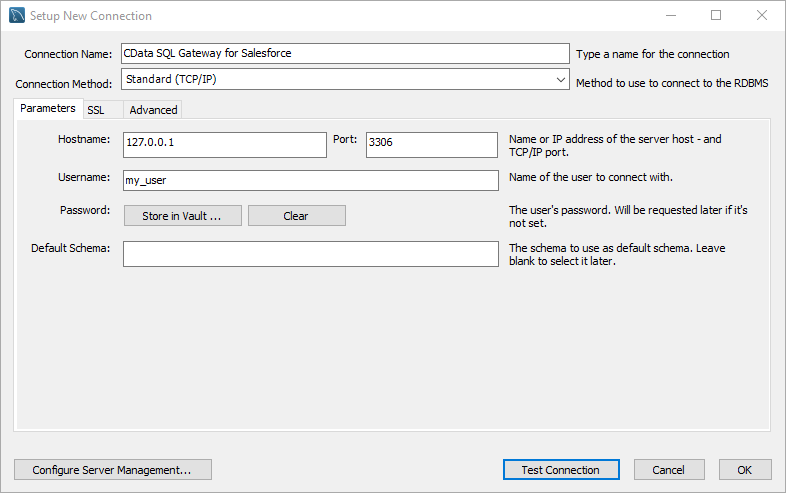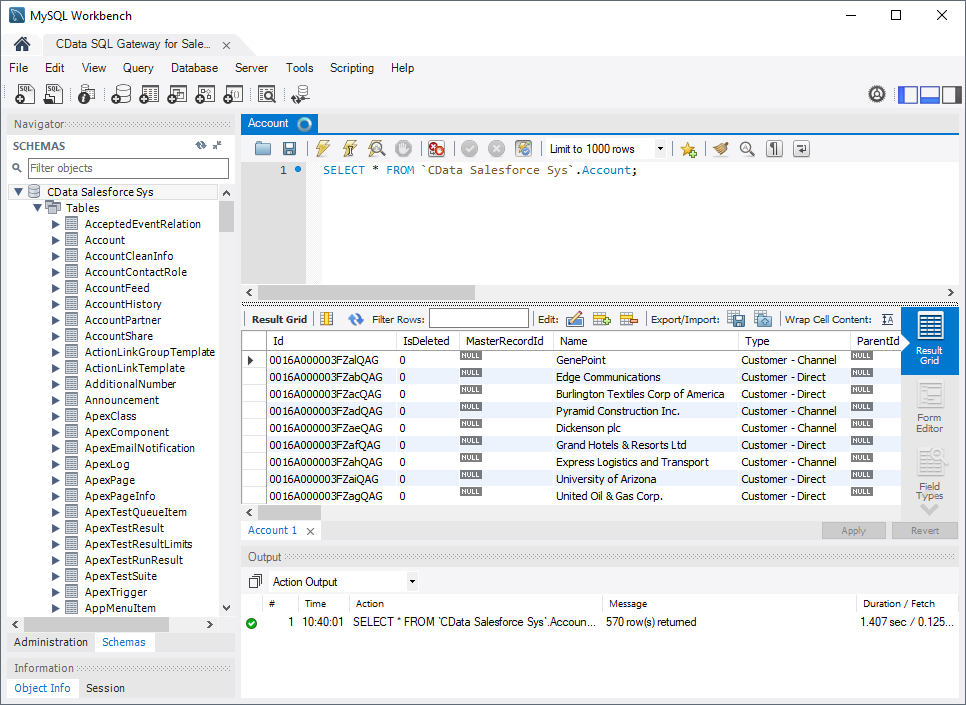Discover how a bimodal integration strategy can address the major data management challenges facing your organization today.
Get the Report →How to Query Zuora Data in MySQL Workbench
Execute MySQL queries against live Zuora data from MySQL Workbench.
You can use the SQL Gateway from the ODBC Driver for Zuora to query Zuora data through a MySQL interface. Follow the procedure below to start the MySQL remoting service of the SQL Gateway and work with live Zuora data in MySQL Workbench.
Connect to Zuora Data
If you have not already done so, provide values for the required connection properties in the data source name (DSN). You can use the built-in Microsoft ODBC Data Source Administrator to configure the DSN. This is also the last step of the driver installation. See the "Getting Started" chapter in the help documentation for a guide to using the Microsoft ODBC Data Source Administrator to create and configure a DSN.
Zuora uses the OAuth standard to authenticate users. See the online Help documentation for a full OAuth authentication guide.
Configuring Tenant property
In order to create a valid connection with the provider you need to choose one of the Tenant values (USProduction by default) which matches your account configuration. The following is a list with the available options:
- USProduction: Requests sent to https://rest.zuora.com.
- USAPISandbox: Requests sent to https://rest.apisandbox.zuora.com"
- USPerformanceTest: Requests sent to https://rest.pt1.zuora.com"
- EUProduction: Requests sent to https://rest.eu.zuora.com"
- EUSandbox: Requests sent to https://rest.sandbox.eu.zuora.com"
Selecting a Zuora Service
Two Zuora services are available: Data Query and AQuA API. By default ZuoraService is set to AQuADataExport.
DataQuery
The Data Query feature enables you to export data from your Zuora tenant by performing asynchronous, read-only SQL queries. We recommend to use this service for quick lightweight SQL queries.
Limitations- The maximum number of input records per table after filters have been applied: 1,000,000
- The maximum number of output records: 100,000
- The maximum number of simultaneous queries submitted for execution per tenant: 5
- The maximum number of queued queries submitted for execution after reaching the limitation of simultaneous queries per tenant: 10
- The maximum processing time for each query in hours: 1
- The maximum size of memory allocated to each query in GB: 2
- The maximum number of indices when using Index Join, in other words, the maximum number of records being returned by the left table based on the unique value used in the WHERE clause when using Index Join: 20,000
AQuADataExport
AQuA API export is designed to export all the records for all the objects ( tables ). AQuA query jobs have the following limitations:
Limitations- If a query in an AQuA job is executed longer than 8 hours, this job will be killed automatically.
- The killed AQuA job can be retried three times before returned as failed.
Configure the SQL Gateway
See the SQL Gateway Overview to set up connectivity to Zuora data as a virtual MySQL database. You will configure a MySQL remoting service that listens for MySQL requests from clients. The service can be configured in the SQL Gateway UI.

Query Zuora from MySQL Workbench
The steps below outline connecting to the virtual Zuora database created in the SQL Gateway from MySQL Workbench and issuing basic queries to work with live Zuora data.
Connect to Zuora through the SQL Gateway
- In MySQL Workbench, click to add a new MySQL connection.
- Name the connection (CData SQL Gateway for Zuora).
- Set the Hostname, Port, and Username parameters to connect to the SQL Gateway.
- Click Store in Vault to set and store the password.
- Click Test Connection to ensure the connection is configured properly and click OK.

Query Zuora Data
- Open the connection you just created (CData SQL Gateway for Zuora).
- Click File -> New Query Tab.
- Write a SQL query to retrieve Zuora data, like SELECT * FROM `CData Zuora Sys`.Invoices;

With access to live Zuora data from MySQL Workbench, you can easily query and update Zuora, just like you would a MySQL database. Get started now with a free, 30-day trial of the CData ODBC Driver for Zuora and the CData SQL Gateway.






